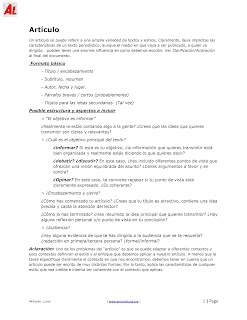 The purpose of this text type is usually persuading people. So, make that connection and think in what a persuasive text looks like and then apply those features to this. In addition to that, pay attention to the design and format, which can be the key for getting this type of text right.
The purpose of this text type is usually persuading people. So, make that connection and think in what a persuasive text looks like and then apply those features to this. In addition to that, pay attention to the design and format, which can be the key for getting this type of text right.There is another key concept we have to keep in mind when writing a brochure, pamphlet... we want to communicate accurate information quickly, in a precise way. No misunderstandings wanted, so be straight forward. Try to include some catchy phrases, bring in your creativity this is the perfect format to express yourself.
To work on this text type with your students check the links provided below.
Don't forget to link this knowledge with their paper 2 and the rubrics they have to use. To make sure you don't miss anything, check out the related posts underneath.
1. Usa el imperativo. Debes decidir si usar el imperativo formal o informal
según el destinatario.
2. Usa marcadores. Si explicas un proceso, necesitas incluir marcadores
como:
- En primer lugar,
- Primeramente,
- Primero,
- En segundo lugar,
- Seguidamente,
- Después,
- Para empezar,
- Más tarde,
- Al + Infinitivo
Ejemplo: “Al llegar al aeropuerto, busca la parada de taxis.”
3. Organiza la información en párrafos claramente diferenciados.
Incluye un título, que puede ser una pregunta:
“¿Cómo se llega a Málaga desde Madrid?”
Related posts:
- Text types [for IB classes]
- Spanish B Rubrics & more
- Spanish ab Initio Rubrics & more
Expand your boundaries:
- Folleto - Afiche [pdf]
- Types of texts with activities [Lenguaparaeso] [pdf]
- Essential information on Articles [Antonio Luna] [pdf]
- Different types of texts [BBC]
Develop a passion for learning.
If you do, you will never cease to grow.
Anthony J. D'Angelo


















